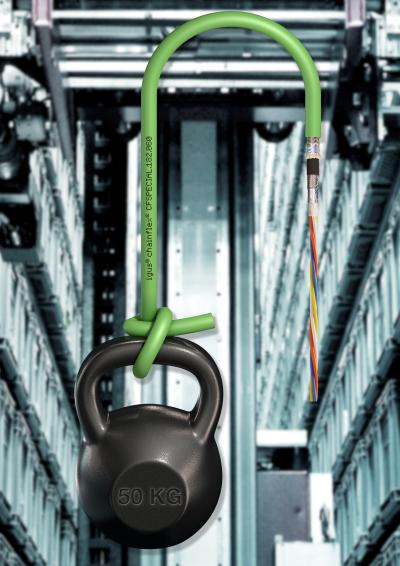
Expanding their line of chainflex continuous-flex cables, the motion plastics specialist has introduced the CFSPECIAL.182.060 cable, specifically designed for maximizing bus communication in hanging applications.
Profinet and other bus signals are transmitted via cables with clearly defined electrical parameters in order to ensure correct data transmission rates. Due to the low levels of current required, the cross sections of these types of cables is typically very small. The cables used are delicate and offer low permissible forces, reaching their mechanical limits quickly in hanging applications, like in modern storage and retrieval systems.
To solver this issue, the continuous-flex cable experts at igus have developed the new, high tensile CFSPECIAL.182.060 bus cable for Profinet. The new cable’s special structure includes integrated strain relief elements which allow the cable to support its own weight in high-tensile or hanging applications. Now, hanging Profinet applications over 100 meters are possible, making igus the only manufacturer of both CAT5e and Profinet cables for high tensile forces. chainflex Profinet and other bus cables for extremely low bend radii are also available, covering a huge range of applications.
The new CFSPECIAL.182.060 cable has a shielded design, featuring an abrasion-resistant PUR outer jacket with integrated strain relief. The cable is resistant to oil, coolants, hydrolysis, and microbes. The cable is also resistant against impacts, and is 100% free of PVC and halogen. Like all chainflex continuous-flex cables, the CFSPECIAL.182.060 has been extensively tested in the massive igus test lab in Cologne, Germany. These test results allow for lifetime calculation based on application criteria, as well as a full cable guarantee for up to 10 million cycles of reliable data transfer.
Contact Details
Related Glossary Terms
- relief
relief
Space provided behind the cutting edges to prevent rubbing. Sometimes called primary relief. Secondary relief provides additional space behind primary relief. Relief on end teeth is axial relief; relief on side teeth is peripheral relief.
